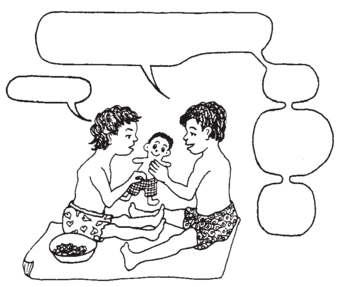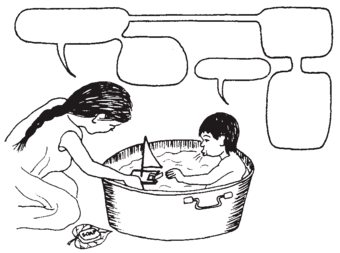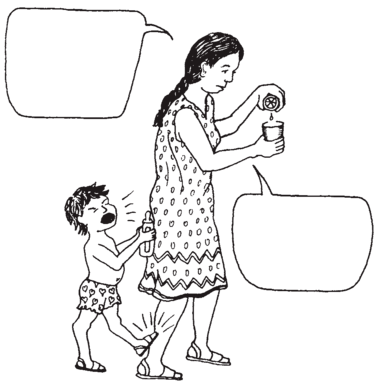Hesperian Health Guides
A Behavioral Approach to Child Development and Learning New Skills
HealthWiki > Disabled Village Children > Chapter 40: Ways to Improve Learning and Behavior > A Behavioral Approach to Child Development and Learning New Skills
Looking at the whole child to decide where to begin
In considering how to help a child’s development, start by looking at what the child can and cannot do. In terms of behavior, we can group our observations into 4 sections:
 Good boy! |
|
 |
|
 |
|
 |
|
It may help to write a list of these different behaviors. Here is a list that a little girl’s mother made with the help of a village health worker who studied this book.
| Child: Celia Age: 4 |
POSITIVE BEHAVORS — ones she now has that we can build on |
IN-BETWEEN BEHAVIORS — ones that have both good and bad points. |
NEGATIVE BEHAVIORS — ones that prevent her progress or disturb the family. | |
 NO! |
|
 |
|
|
|
 |
| ||
|
 | |||
|
|
 | ||
|
KEY NEEDS (in order that new skills and behavior can develop)
| ||||
Deciding where to begin
After they listed these behaviors and considered Celia’s key needs, the health worker helped her mother plan where to begin. He explained that, since we cannot change everything at the same time, we need to decide what things need to be done first (choose priorities for action). So we choose the behavior we most want to introduce or change.
- If we are trying to introduce a new behavior or skill, we need to think of all the different parts that make up the behavior. Next we plan the separate small steps that lead to the skill. We encourage the child to advance step by step, making clear what we expect for each step and consistently giving praise and small rewards.
- To improve an “in-between behavior,” we can help the child by working with a skill she has already developed a little. First we need to think about the various parts of her behavior that concern us. Then we decide which parts seem helpful and which do not. We then reward the good behavior and ignore the bad. As the child gradually improves, we can expect more of her before giving a reward, until the whole improved behavior is achieved.
- If we are trying to reduce or stop an old behavior we need to do 2 things. First we note when and where the behavior happens, and what happens before, during, and afterward. We observe carefully both what the child does and what we ourselves do. Second, we try to guess what the child gains from her bad behavior. We can then try to change things so that good behavior is more worthwhile than the bad. To do this we reward the new good behavior and refuse to give attention for her bad behavior.
Thinking about Celia’s behavior, her mother realized that she already has the beginnings of many valuable skills. She uses her hands well and has begun to develop skills for feeding and dressing herself. She also speaks a few words — although it would be nice if she could say “yes” as well as “no.”

It is important that she likes praise and hugs, and bathing, and rough play. This means she will probably learn well with a reward-based approach.

However, certain things seem to be stopping Celia from developing her skills more. Not being able to sit still and give attention makes it hard for her to learn from other people, or even to learn to enjoy her toys (which she always throws). Also, her baby bottle is a big problem. She is much too old for it, but her mother is afraid to take it away because Celia screams. Her mother fills the bottle with sweet drinks (which have already begun to rot Celia’s teeth). The biggest problem is that by always holding her bottle, Celia’s hands are not free to do other things—such as play with her toys or take down her panties when she has to pee-pee.
For these reasons, Celia’s mother decided that the ‘key needs’, which need to be solved in order to advance in other areas, are:
- helping Celia learn to sit quietly and give her attention to something
- helping Celia grow out of her need to always hold her bottle
The health worker discussed with Celia’s mother what she might do. To help Celia learn to sit quietly and pay more attention to things, her mother decided to start with the times when Celia was already willing to sit fairly quietly—which was mealtime and bathtime. For example:
| After giving Celia her food, but before her final “sweet,” her mother or her older brother, Oscar, plays quietly with her for 5 minutes or so, praising her whenever she gives attention. | Her mother also uses bathtime as an opportunity to help her concentrate on toys and to give attention to words and sounds. |

Pee-pee.
That's right! Dolly has to go pee-pee! Help him pull down his pants.
Good girl!
Tell Dolly he is a good boy!
Say "Good boy." |
 The boat goes Brrrr.
BRRRRR
Good girl!
Now you wind it up!
Good Celia! Now watch it go!
|

Celia’s mother decided to help her outgrow the bottle little by little. For a start, she filled it with water only. After a few days, she refused to fill it at all.
At first Celia screamed and kicked. But her mother did her best not to give Celia any attention when she acted that way. As soon as Celia was quiet, however, she would give her a tasty drink from a glass, or some other reward.
Sometimes Celia would throw her empty bottle in anger. But after a while she began putting it down, more and more often, to pick up other toys or objects. Finally, her mother simply removed the bottle from sight.
After Celia had forgotten her bottle, she started to explore more with her hands. When she needed to go “pee-pee,” she began to lower her panties by herself; in a few weeks she was toilet trained. She also began to play with her toys more, instead of just throwing them. As she learned to give longer attention to things, she discovered lots of things that gave her pleasure. Many of her behavior problems such as screaming, spitting food, and kicking began to disappear. Her mother, father, and brother spent more time playing and talking with her. They praised her when she behaved well, and did their best to ignore her bad behavior.

Where it seemed necessary, her mother began to use a behavioral approach to help Celia develop other skills: dressing, eating, and talking. To increase her language skills, together they looked at picture books and listened to songs.
As a result of her family’s efforts, Celia has grown up a lot, and is a much happier and more able little girl. Thinking about the changes that took place, her mother said, “I think my behavior has changed as much as Celia’s. I was still treating her like a baby—bottle and all! Now that I expect more from her and show her how much I appreciate her effort, she has developed a lot faster, and is a lot easier to live with. She and I have both come a long way!”
Examples or methods for helping children develop basic skills using a behavioral approach are discussed in other chapters: Feeding, Chapter 36; Dressing, Chapter 37; and Toilet Training, Chapter 38. We suggest you also read again the chapter on child development, Chapter 34, and consider how a behavioral approach can be useful for helping a child through many difficult areas of development.


